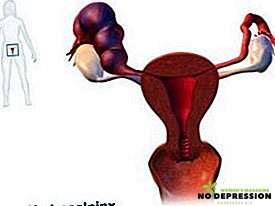Infertility in women is the absence of pregnancy for 1-2 years with regular sex life. Experts identify several forms of this pathology, and each of them develops for specific reasons. Female infertility is considered a severe psychological trauma.
How to determine the disease

Talk about female infertility should be in the case if with a full sexual life within 12 months, pregnancy does not occur. In that case, if the age of patients exceeds 35 years, then the period is reduced to six months.
When infertility is usually absent any bright symptoms, except the inability to conceive a child. Increasing or lowered body mass index, breast pathology, gynecological diseases and endocrine disorders in the body can serve as provoking factors.
Types of infertility

Experts identify several types of infertility, each of which develops under the influence of certain factors:
- Primary infertility is placed on a woman if she has never been pregnant before.
- Secondary infertility means that the patient has already had a pregnancy or childbirth in the past, but problems arise with repeated conception.
- Absolute infertility is a pathology in which the patient has no fallopian tubes or genital organ. Not so long ago, it was believed that in such a situation a woman could not become a mother, but the emergence of IVF allowed to make the dream of a child a reality.
- Relative infertility is usually always provoked by the reasons that prevent the occurrence of pregnancy at the moment. This type of pathology is classified into temporary and permanent infertility.
- Genetic infertility can occur in both women and men. To suspect this type of pathology can be with miscarriage in two or more cases.
In addition, women can be diagnosed immunological infertility due to impaired reproductive function. The main manifestation of this pathology is the defeat of sperm with antisperm antibodies. Most often, the problem is acquired and occurs as a result of past or chronic infections of the genital tract.
When tubal infertility violated the patency of the fallopian tubes. Often this pathology has no bright symptoms and does not cause any discomfort to the woman. With the help of laparoscopy, it is possible to assess the degree of obstruction of the tubes and to achieve a therapeutic effect.
The cause of endocrine sterility in women is the dysfunction of the ovaries, adrenal glands, thyroid and pituitary. A woman's body breaks down the production of hormones, which prevents the normal process of maturation of the eggs. Normal endocrine sterility is temporary and disappears after the restoration of hormone levels.
Uterine infertility is a consequence of one or more pathologies of the uterus. In order to confirm this type of pathology, it is enough to study the clinical picture, conduct a gynecological examination and make an ultrasound.
Polycystic is considered a rare cause of infertility and is accompanied by the appearance of small formations in the ovaries. The main manifestation of such a violation are failures of the menstrual cycle, and it is successfully treated at an early stage of development.
Endometriosis is a disease in which the endometrium or similar tissue is visualized outside the cavity of the genital organ. The reasons for this pathology can serve as various mechanical factors, immunological and hormonal disorders.
How to diagnose female infertility

Diagnosis of infertility, in addition to studying the history of women and conducting a visual gynecological examination, includes the following studies and tests:
- Analysis for hidden infections. This procedure must pass both partners.
- Blood test for hormones. With this procedure, it is possible to identify the endocrine cause of infertility. To study various hormones, blood is taken in different phases of the cycle.
- Ultrasound of organs and radiography of the pelvis. With the help of X-ray studies, it is possible to determine whether a woman’s infertility is not due to deformation of the reproductive organ or its pathology. In addition, the condition of the fallopian tubes, the presence of adhesions and neoplasms are evaluated. Ultrasound is used to clarify the condition of the fallopian tubes.
- Hysteroscopy. During this procedure, a miniature video camera is introduced into the uterine cavity, with the help of which it is possible to see polyposis tumors of various nature and changes in the structure of the mucous membrane. In addition, in the course of histology, tissue sampling is carried out for research.
Another informative diagnostic method is histology, during which the uterus mucosa is examined. Using the procedure, it is possible to obtain information about the cellular structure of the endometrium.
The main causes of pathology
Modern medicine identifies the following reasons for the long absence of pregnancy:
 violation of the patency of the fallopian tubes, in which the mature egg can not physically meet with the sperm;
violation of the patency of the fallopian tubes, in which the mature egg can not physically meet with the sperm;- malfunctions in the organs of the endocrine system, that is, hormonal disturbance;
- congenital or acquired pathology of the structure of the uterus;
- increased prolactin production;
- tumors of a different nature of the pituitary gland;
- endometriosis;
- adhesive processes occurring in the pelvis;
- acquired malformations of the genital organs;
- psychosexual disorders;
- systemic autoimmune pathologies;
- tuberculosis of the genitals.
In addition, there is such a thing as immunological incompatibility. In this condition, antibodies to the male sperm cells, to the tissues of the own ovary and the endometrium are produced in the female body. The cause of infertility can be genital infections, occurring without the development of pronounced symptoms. They can provoke internal inflammatory processes that cause tubal adhesions.
Overweight can cause an imbalance of hormones in the body, since adipose tissue is an organ produced by estrogen. The lack of adipose tissue causes an imbalance of estrogen in the female body and, as a result, the menstrual cycle fails.
Female Infertility Treatment
Drug treatment of infertility includes hormonal drugs, due to which it is possible to normalize the level of hormones in the body. This allows you to improve the maturation of the follicle and the release of the egg from the ovary.

Drug therapy helps to achieve a positive result if endocrine disorders are the cause of infertility. The effectiveness of therapy is determined by the patient's age, the duration of infertility and the state of the ovaries.
For pathologies of the uterus and fallopian tubes, surgical treatment is indicated. With the help of laparoscopy, it is possible to restore the patency of the fallopian tubes, get rid of adhesions, remove myomatous nodes and perform coagulation. After the procedure, a course of drug treatment is usually prescribed to consolidate the effect obtained. However, surgery can not always solve the problem of infertility in cases where a woman has serious defects of the uterus and fallopian tubes.
Treatment of infertility in women folk remedies
Most often, women are diagnosed with infertility caused by various inflammations, adhesions and endocrine disorders. To cope with this problem, you can use alternative medicine:
- Sage tea. It is necessary to pour a tablespoon of a plant with a glass of boiling water and infuse the mixture for 40 minutes. It is recommended to take this remedy half an hour before meals, adding a little honey or lemon to taste. The course of treatment with such a folk remedy should last at least a month, after which a break is taken.
- Infusion of root root. To prepare the product, you need to grind 50 grams of the root and brew it with 500 ml of vodka. Infuse the resulting mixture for at least 14 days in a cold place, then drink 10 ml several times during the day. The course of therapy is 1 month, after which a 10-day break is taken and treatment is resumed.
- Plantain decoction. It is necessary to brew a tablespoon of plantain seeds with a glass of boiling water and simmer the resulting mixture on the fire for no more than 2-5 minutes. After decoction remove from heat, insist and filter. Take this tool in the form of heat 10 ml several times during the day for three months.
Often infertility becomes a consequence of various infectious and inflammatory pathologies occurring in the organs of the reproductive system. For this reason, women need to visit a gynecologist at least once a year.
Unscheduled examinations should be mandatory when changing the sexual partner, the occurrence of any changes and unpleasant symptoms. The birth of a child is an important event in the life of every woman; therefore, one should approach this event with full awareness and responsibility. Treatment of the diagnosis should begin immediately after the diagnosis.


 violation of the patency of the fallopian tubes, in which the mature egg can not physically meet with the sperm;
violation of the patency of the fallopian tubes, in which the mature egg can not physically meet with the sperm;









